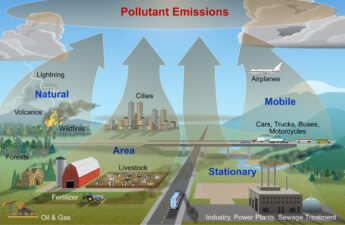
By Alex Brown, Stateline
When American farmworkers, construction laborers and trash collectors die in extreme heat, it’s rarely because their employers have broken any rules. It’s because there are none.
Federal safety regulators have issued no standards to protect workers from heat-related hazards, even as climate change increases the risk of deadly heat waves and extreme weather conditions.
But some states have begun acting on their own, requiring employers to provide shade, cooldown breaks and drinking water, among other measures.
Washington state and Oregon issued emergency standards last month after a heat wave broke temperature records across the Northwest and caused hundreds of deaths. Maryland regulators will issue heat rules by next year, after lawmakers passed a bill requiring them to do so. And Virginia officials announced earlier this year that they have begun the rulemaking process for a heat standard.
“There are very easy ways employers can address it, which is why we’ve been calling for [the federal Occupational Safety and Health Administration] to act for many years now,” said M.K. Fletcher, a safety and health specialist with the AFL-CIO, a federation of labor unions. “If we can’t do it federally, states need to recognize that all people deserve the same protections and everybody deserves to come home at the end of the day.”
Shannon Foley, a stagehand in Tucson, Arizona, spoke last week at an event to raise awareness of the heat risks workers face and push for more protections. Foley is a member of the International Alliance of Theatrical Stage Employees Local 415.
“Prior to becoming a union member, I worked with employers that put us in unhealthy situations in order to get the job done,” she said. “It wasn’t unusual to leave the work site with a splitting headache or nausea that would last the rest of the day. I’ve witnessed co-workers that had to leave the job due to heat stroke or exhaustion, and a lot of them did not return to the work site.”
Foley called on state regulators to issue heat standards, saying the protections she now enjoys—including rest breaks, water and the ability to prioritize her safety without fear of retribution—should be available to all workers.
Under the Biden administration, OSHA has announced that in October it will begin exploring the possibility of creating a heat standard, according to E&E News. But that process is expected to take years, worker advocates say, leaving state rules as the only near-term option to protect workers.
Only four states have extreme heat standards. Washington and Oregon are working on permanent rules to replace the emergency regulations issued this summer. California has standards to protect outdoor workers, while Minnesota’s rules apply only to indoor workers. California, which first issued heat rules in 2005, pioneered standards for benefits such as shade, water and rest breaks.
But states face hurdles, including concerns from industry groups about a lack of input and overly burdensome training requirements. And even as more states consider heat rules, many workers will remain unprotected. Only 21 states have their own agencies that oversee workplace safety for the private sector, while the rest rely on the federal OSHA.
U.S. Rep. Judy Chu, a California Democrat, has sponsored legislation that would compel the federal agency to act, and a trio of Democratic senators have introduced a companion bill, but for now, scattered state-level efforts remain the only foothold that worker advocates have found.
Federal and state regulators may have some ability to prevent heat risks under a general duty clause that requires workplaces be “free from recognized hazards.” But last year, a Washington, D.C., judge overturned five OSHA citations issued under that clause, saying the lack of a specific heat standard created a higher burden of proof for the agency to show employees were endangered.
“It’s harder now to regulate heat using the general duty clause, and that shows the real need for a standard,” Fletcher said.
Last week, a joint report published by NPR and Columbia Journalism Investigationsfound that at least 384 workers died from environmental heat exposure in the past decade. Since the early 1990s, the investigation found, the three-year average of worker heat deaths has doubled. Companies frequently avoided punishment for worker deaths, the findings showed.
While OSHA’s poor recordkeeping on heat deaths prevented a full accounting of the toll, the reported figures showed that Hispanic workers suffered disproportionately from heat fatalities.
“A lot of the states where this is a consistent problem and has always been a problem are very agricultural states,” said Juley Fulcher, worker health and safety advocate with Public Citizen, a consumer advocacy nonprofit based in Washington, D.C.
“In a lot of places, farmworkers don’t get breaks, they don’t have water provided, they don’t have shade. It’s crazy to think about working a 12-hour day under those circumstances.”
Northwest Action
When a record-breaking heat wave sweltered the Northwest in June, an Oregon farmworker died on a work site while moving irrigation lines in 104-degree heat. Days later, Oregon OSHA issued emergency heat standards, even as the rulemaking process for a permanent standard was already underway.
“The unprecedented and deadly heat wave in the Pacific Northwest highlighted the immediate risks, making it necessary to adopt a temporary rule while the permanent rulemaking process continues,” said Aaron Corvin, a spokesperson with the agency, in an email to Stateline. “The risks of working in high heat are not going away this, or any, summer.”
Oregon’s temporary rule requires employers to provide enough shade for all workers on rest or meal breaks, as well as 32 ounces of drinking water per hour for each employee when the heat index reaches 80 degrees. At 90 degrees, employers additionally must monitor their workers for signs of heat illness, provide cooldown rest periods and develop emergency medical plans. Worker safety advocates say the standards are the strongest in the country.
“Workers understand they now have a lot more protections around heat in Oregon,” said Kate Suisman, an attorney with the Northwest Workers’ Justice Project, which provides legal support and education to low-wage workers. “If you can take those preventative cooldowns, you’re much less likely to get sick.”
Jenny Dresler, a lobbyist with the Oregon Farm Bureau, the state’s largest agricultural advocacy group, noted that the new standards came into effect at the same time as new rules on wildfire smoke, labor housing and COVID-19.
“As reasonable as these might seem on their face, there are still incredible training requirements and burdens to implement rules that are not always clear and easily understood,” she said. “The fact that these all came into effect within a three-week period just doesn’t give anybody time to get into compliance or understand the rules.”
Washington state regulators also issued an emergency heat standard in July, replacing existing rules that Fulcher described as “vague and nonprescriptive.”
But labor advocates in Washington say the new standard is also inadequate. The rule’s provisions requiring shade and cooldown rest periods kick in only at 100 degrees. At 89 degrees, businesses must provide water, allow—but not mandate—rest breaks and have a heat exposure safety program.
“One hundred degrees is such an egregiously high number that is obviously not based in any science or health data,” said Elizabeth Strater, director of strategic campaigns with United Farm Workers, the labor union founded by Cesar Chavez and other organizers.
Strater noted that a Washington farmworker died last month in temperatures near 100 degrees.
“It’s just epically tragic because the employer is saying it was in the high 90s,” she said. “That one degree is the difference between a citation or not, but it doesn’t make a difference for his widow and his children. These rules are absolutely inadequate.”
Matt Ross, public affairs manager with Washington’s Department of Labor & Industries, said the rule was written in response to a petition from farmworker advocates, noting that future rulemaking could include stronger protections.
“We are working on a permanent rule that could lower both trigger temperatures,” he said in an email.
Farmworkers at Risk
According to the federal Centers for Disease Control and Prevention, farmworkers are 20 times as likely as other workers to die from heat stress. Labor rights groups say workplace safety officials have been slow to issue heat rules because the workers at greatest risk have been historically marginalized and have little political power.
Many farmworkers also work for “piece rate” wages, meaning they’re paid for each bushel or carton they pick rather than hourly. That makes it more difficult for them to take breaks and protect themselves.
“There’s an economic desperation that gives you this incentive to push your body as hard as you can,” Strater said. “When you drink water and have to take breaks to go to the bathroom, that’s money that’s coming out of your family’s pocket at the end of the day.”
California has confirmed 17 heat-related deaths among agriculture workers since the 2005 standards were issued, the most of any industry in the state. Cal/OSHA, the state’s agency, has reported 193 heat illnesses in the sector since 2007, more than other occupations including construction and firefighting.
Agribusiness groups say their farmers already take steps to protect workers.
“For the most part, the emergency rule was not a lot of new information,” said Jon DeVaney, president of the Washington State Tree Fruit Association. “It was useful to have people reminded of the need to do those things. There is risk, which is why it is so important to have these safety rules in place, but this is not something that we only started paying attention to when we had the heat dome event.”
While DeVaney did not object to the new standard, he did say the emergency rule was issued without advance notice and gave little time for farm owners to adjust.
Tom Davis, director of government relations with the Washington Farm Bureau, an advocacy group with more than 46,000 members, said in an email that the group prefers “education over enforcement,” but did not address the specific requirements in the emergency rule. The process did not allow for public input, he said, questioning the necessity of setting the standard without first seeking feedback from employers.
“They have adjusted as needed by providing extra drinking water, taking extra breaks and rescheduling work to take advantage of cooler hours earlier in the day,” Davis said. “As far as I know, we have not seen an increase in heat-related illness claims this year.”
Ross, the Washington official, said heat-related claims take time to identify, and any count in the state’s system right now would be an undercount. He added that many heat-related illnesses don’t show up in the agency’s claim system.
Farmworker advocates say that heat-related illnesses often go unreported, obscuring the danger workers are facing.
“Workers don’t necessarily report, ‘I was feeling a little faint,’” said Fletcher, the labor leader. “We don’t have a good picture of the real scope of the problem.”
And many heat-related injuries are likely not categorized as such. A study earlier this year conducted by UCLA and Stanford University found that California workers were more likely to be hurt in accidents on hot days. The study found that heat causes 20,000 workplace injuries a year, although state officials report only a fraction as heat-related.
“In hot weather, you’re going to have more ladder falls, tractor rollovers and pesticide handling errors,” said Strater, the farmworker advocate. “People in general are making more mistakes in extreme heat.”
‘Get It Right’
Maryland state Del. Lorig Charkoudian, the Democrat who sponsored the bill requiring standards by October 2022, said she had urged state regulators to issue heat standards and wrote legislation to force their hand when they failed to do so.
“Our Department of Labor in Maryland has been a real disappointment,” she said. “They’ve been very hesitant and not willing to step up and do what it takes to protect workers.”
Charkoudian’s bill requires Maryland Occupational Safety and Health to consider standards crafted by worker safety groups and to issue rules that will apply to both indoor and outdoor workplaces.
And in Virginia, the state Safety and Health Codes Board announced in May that it intends to issue a new heat-related standard to protect workers, kicking off the lengthy rulemaking process there.
As more states look at the issue, the private sector is taking notice as well. The American Society of Safety Professionals, an advocacy and education group for workplace safety leaders, is working on a heat standards document for the construction industry, which would offer voluntary guidelines and best practices. Fletcher, the labor leader, said such standards are followed by good employers, and increased adoption could push states to make those practices mandatory.
Still, most states still lack jurisdiction over workplace safety in the private sector, and safety advocates say federal action is long overdue.
“We obviously want the federal government to get it right,” Charkoudian said. “If they would just do it, we wouldn’t have to, but someone has to protect Maryland. Hopefully that becomes the pattern and the trend and that leads to the federal government acting.”
Stateline is a nonpartisan, nonprofit news service of the Pew Center on the States that provides daily reporting and analysis on trends in state policy.


